
By John, Certified Holistic Health Coach
Project One-Eleven is our non-toxic home renovation project. We’re taking an old row house that’s been serving as an office and converting it back into a residence where you’ll be able to come test mattresses and other Good Stuff. Because we’re all about the Good Stuff, we’re using non- toxic and sustainable products, materials, and processes as much as possible. We’re blogging about the process to share the joys and challenges of taking a non-toxic approach to home renovation.
Once we had finished redoing the wood floors and installing kitchen cabinets, we began considering how deep of a reno we wanted to do in the two bathrooms. Actually, the third-floor bathroom was a kitchenette when we bought the place, so we knew that it would be a big project to turn this into a master bath/laundry room.
The second-floor bathroom, on the other hand, already had a tub/shower combo, complete with tiled walls. While this room wasn’t particularly pretty (basic white 4X4 wall tile), we decided to keep much of it intact because it is fundamentally very sound and didn’t present any toxins, with one major exception: vinyl floors!
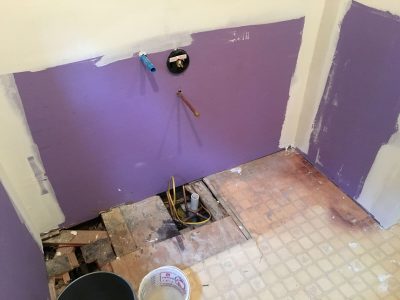
The floors in both bathrooms were this hideous vinyl.
Toxic Vinyl Flooring: How Long Does it Off-Gas?
Unfortunately, the floors in both of the would-be bathrooms were vinyl, as is not unusual in many modern homes. Vinyl flooring is not only toxic, but does not age particularly well. After only a few years it can often look faded, worn, curled, and generally hideous. The ones in One-Eleven were quite “vintage”…meaning they had expired long ago. Both floors had to be replaced.
Vinyl (PVC) can off-gas for as many as twenty years, so it’s something we feel is always worth replacing. The vinyl in One-Eleven was so old (I would guess more than 30 years) that it actually had probably finished the off-gassing. Therefore, in order to get an aesthetic we liked, we only had to go over these floors with another material, rather than removing the vinyl entirely.
Non-Toxic Bathroom Floor Options
Of course, another coat of vinyl was out of the question for our project. Non-toxic flooring options include:
- Wood (learn about safe finishes here)
- Cork
- Linoleum
- Bamboo
- Stone tile
- Ceramic tile
In an area likely to experience significant exposure to water, it is easy to decide against wood. Cork is relatively water resistant, but still not the best for bathrooms. Ditto for linoleum, which, by the way, is NOT the same as vinyl flooring, although they are often confused. (True linoleum is made from natural components like linseed oil and limestone.) Bamboo might have worked for our bathroom projects, but it too can be damaged by repeated dousings.
This left us with stone tile and ceramic tile. Ceramic and stone tile are some of the least toxic materials found in modern construction. They are also attractive, durable, highly water resistant and generally timeless. If you’re doing a bathroom renovation, either one will work beautifully.
Considering the look and feel we wanted in the house, we decided on white (Carrera) hexagonal marble tile. We chose one larger, and one smaller so the bathrooms would look different.
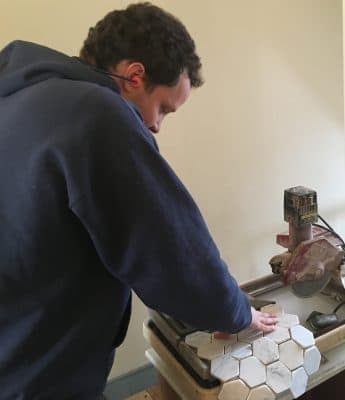
Choosing Non-Toxic Grout and Mortar
When it came to mortar and grout, we made sure to use only unmodified products. Modified mortar and grout contain latex additives that outgas for a short while after installation; because Daylon and I were doing the installation ourselves, we definitely wanted all materials to be toxin-free.
Installing Our Non-Toxic Tile
The second-floor bathroom installation was done with a product called Ditra-mat, which is a thin, inert, non-toxic plastic grid that covers existing floors and makes an excellent subfloor for tile installations.

The3rd-floorr bathroom also had this refrigerator to contend with; we opted to lower it out the window!
Upon closer inspection, we found the structural integrity of the third-floor bathroom floor to be lacking. We decided to beef it up while providing a suitable surface for tile. We used a gypsum backer board and screwed it down with a grid pattern that resulted in a screw about every four inches. That floor is going to stay put!
We also decided to install the same tile in a 3×6 subway pattern on the walls surrounding the tub on the third floor.
In the end, we got a very durable, water resistant, non-toxic installation with a look that we loved. Here are the “after” photos of each bathroom:
We’d love to hear your thoughts, as well as your own experiences working with tile.
Stay sane!
P.S. Did you know that Project One-Eleven is now open for visitors? Reserve your stay here and email Suzanne to make an appointment to come test mattresses or purchase select items from our store.
If you liked this post, sign up for our newsletter to be alerted when we publish new content like this!

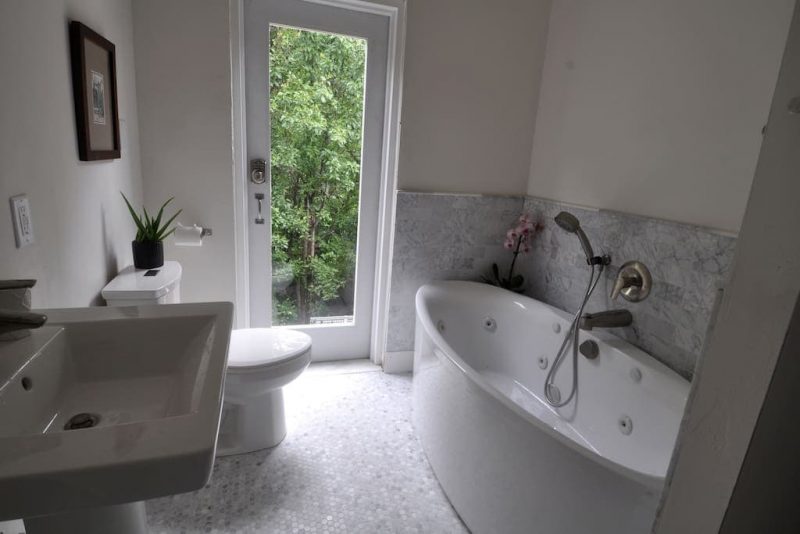
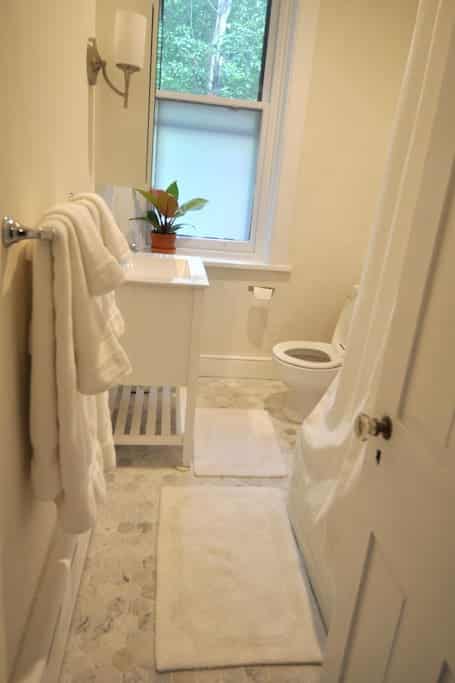
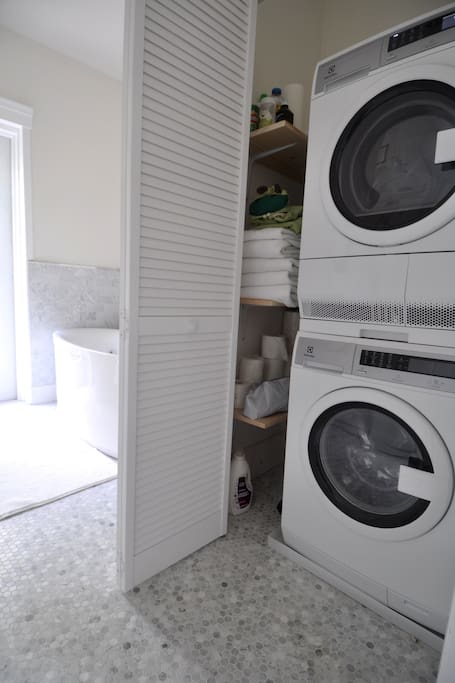





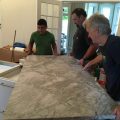

Gina says
You’ve done such an amazing job on this very meaningful project John and taught us all so much. Thank you for your vision, your perseverance and for sharing your expanding knowledge. I so look forward to staying at Project One-Eleven and experiencing all you’ve done.
John says
Great job. Love the carrera marble hexagonal- also, we had porcelain tile on our new reno w/grout from Greenbuildingsupply.com. Our porcelain tiles look like real wood. I have MCS, and was still apprehensive about real wood… We love our floor. What brand is your bathtub? It’s very nice. Can a new tub off-gas for awhile. What material should I look for? Thank you and congrats on your beautiful space and choice of safe materials.
John Goss says
Hi John,
Thanks for the kind remarks and questions.
Here’s what we know about tubs…
Most tubs are available in 3 versions…Cast Iron/Porcelain, Polyester resin/fibergalss, Epoxy resin/fiberglass
Our research found that although the old school cast iron/porcelain tubs have been around for a long long time, they may not be totally benign. A recent study found that 62% of porcelain lined iron tubs leached lead! Yikes!
Epoxy resin is far less toxic than Polyester resin but that is only because polyester resin requires styrene to harden, and styrene is pretty toxic stuff.
The good news is that when polyester resin if fully cured, (1-2 weeks) the styrene is gone and the remaining resin/fiberglass product in essentially nontoxic.
Epoxy is considerably more expensive and so it is not commonly used.
Due to the age of the house, the stairway to the 3rd floor is quite narrow and so we had to find a tub that could physically fit up the stairway. This severely limited our choices, but we did finally find a polyester tub to suite our needs. It looks and works great.
Best,
John
Kristen says
Can I ask what manufacturer you used for your 3×6 subway tile?
Thank you!
John Goss says
Hi Kristen,
The 3×6 tile are not ceramic. They are marble.
Like this:
http://amzn.to/2jRKKUs
Erika says
Did you have your tile tested for lead? We are possibly moving into a new build and I’ve been trying to research the safest flooring options without spending an obscene amount. I love subway and hexagon tile but keep coming across how most tests positive for lead.
Lindsay says
I second this! About to redo all of our floors and read a lot of ceramic tile in the US will state that it is lead free, but when tested they find high levels of lead. I have read concrete tiles are the way to go with an AFM seal if not seal already. Concrete tiles are harder to find and I’m wondering if you know of any trusted companies that sell ceramic tiles tested free of lead. Thank you for all that you do to help us sort the research out! 🙂
Charlotte says
I am also curious about this. We are soon to be replacing the tile in our bathroom. But we want to first find out if the current tile has lead so we don’t fill the house with lead dust and we want to buy new ceramic tile that is lead free. We are having a hard time trying to find new lead free tile and would appreciate any tips. Our daughter already has elevated lead levels so this is really important to us. Any ideas??
WS says
Hi Charlotte! Did you ever find the answer to your question? I am trying to figure this out too.
Helen says
Please explain ‘unmodified mortar/grout’, what products did you use to fix the tiles?
Helen says
Please explain ‘unmodified mortar/grout’, what products did you use to fix the tiles? Thank you !
John Goss says
Hi Helen,
In essence there are 2 basic types of thinset mortar. This was not always the case. Years ago there was only “mortar”, which is a type of cement/sand mixture that is mixed with water to make the adhesive used to stick ceramic/porcelain/stone tile to a surface like a floor or wall.
About 40 years ago “modified” thinset mortar was invented and it has dominated the market ever since. From a tile setters perspective it is often much easier to work with modified mortar. Modified means that a variety of chemicals are added to enhance to use-ability and performance of the mortar. Unfortunately, those chemicals can be toxic.
The good news is that there are still enough reasons to produce unmodified mortar, so it remains widely available.
Mortar is what is used to adhere tile to a surface. Do not confuse it with grout, which is used to fill the cracks between individual tiles.
Sherrie says
Do you have to worry about Radon with Marble tile?
Dan says
I have read that ceramic, porcelain tiles can be somewhat high in radon? How does one test? Love your work!
WS says
Hey Dan! Did you ever find an answer to your question? I’m curious as well.
Heather says
Have you found a good shower door and tub? I see you have a bath? Are the old plastic ones ok or should we only go with ceramic? Also, what about shower doors? Is an EVA curtain Better than tempered glass with coating?
Gerard says
Can I do a polished concrete floor? If so, do you know of any non-toxic products to get it done?
Nina says
Hi, can you recommend a nontoxic mortar or adhesive for putting ceramic tile on a new floor? And also a grout? Reading this blog though, now I’m wondering if the tiles I got (pretty sure they’re ceramic and not porcelain) have lead. How do I test them? Is there something I can buy? Thx.
Shermie Garcia says
Thanks, JOHN GOSS for such type of natural product implementation. Here you explain Non-Toxic tile. But I want to know that how much stronger than artificial titles.
ALEJANDRA NEIRA says
Did you consider epoxy resin or microcement? If not, can you tell me why?
Lynn Z says
Hey there! Gorgeous renovation! I have severe chemical sensitivities so I’m concerned about the quality of the tiles (potentially lead or other issues), where do you guys get yours from? They are gorgeous!